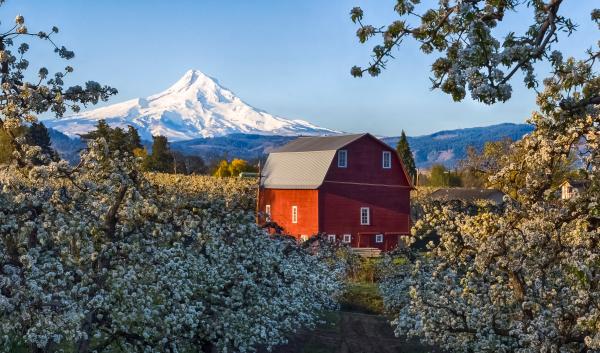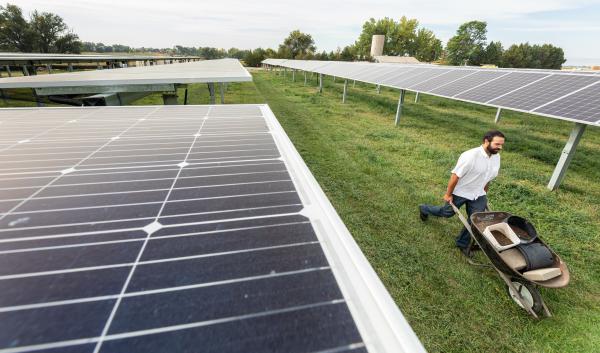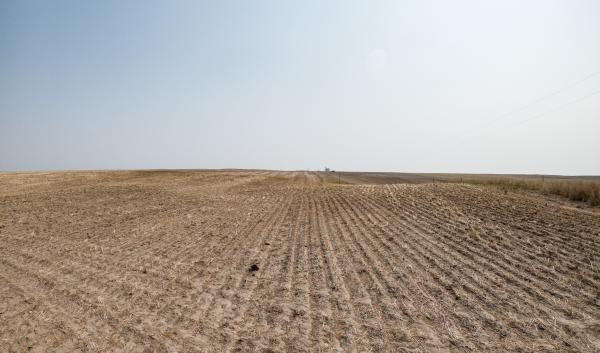Farmers have been adapting to climatic conditions for centuries often using irrigation as an adaptation tool. In the Northwest, climate models project warmer and slightly drier summers and a reduction in summer water availability due to more precipitation falling as rain rather than snow, reducing snowpack. Thus, climate change may limit irrigation as a viable adaptation tool for many western producers. Producers had a glimpse of future growing conditions and water availability during the 2015 drought in the Northwest, which resulted in regional water cutbacks. Because western water law assigns priority based on seniority, producers with junior water rights are more likely to be affected by water shortages than senior water rights holders.
Dry farming in western Oregon and Washington can help producers adapt and diversify in response to lower water availability and changes in climate. It is especially useful for producers who have little or no access to irrigation water. Dry farming techniques include management practices and crop varieties that make use of residual soil moisture during droughts and the dry summer season in the Northwest. However, there is a shortage of research on the influence of soil types or the effect of management practices on the quality and productivity of crops in non-irrigated settings. In response, the USDA Northwest Climate Hub collaborated with Oregon State University Extension Service’s Small Farms Program and the Dry Farming Collaborative (DFC) to better understand effective dry farming practices. The collaboration consists of farmers, extension educators, plant breeders, and other agricultural professionals.
One goal of the Dry Farming Collaborative is to understand the effects of climate change on Northwestern agricultural operations. The second objective is to determine how dry farming methods can mitigate these impacts in water-limited regions (or situations i.e. junior water rights holders during a drought). A third objective is to facilitate farmer-to-farmer information sharing within the Dry Farming Collaborative, and to partner with scientists to improve communication about dry farming techniques and benefits. Some advantages of dry farming include reduced water costs, as well as some potentially unexpected benefits of water stress (i.e. increase flavor). Under the right circumstances, some crops, such as tomatoes and grapes, actually increase in flavor from water deficits.
A major outcome of the project is the development of a “how-to” guide for participatory climate adaptation research projects. To create this guide, data are being collected from growers who have signed up to host multi-year dry farming variety trials. The trials cover a wide range of geographic regions, from coast to valley, in western Oregon and Washington. The overarching goal is to collect data from dry farming trials over a wide range of geographic conditions west of the Cascades. Data being collected at demonstration sites include:
- management practices and soil preparation activities
- soil testing
- crops and varieties planted
- planting date(s) and density
- harvest date(s) and yields
- field notes on pests, disease, and weeds
- depth of the water table
- sensory evaluation for marketability (i.e. color, texture, sweetness)
A data repository is being developed to facilitate coproduction of scientific knowledge and decision support. The data repository will be used to archive and interpret the results of the participatory variety and breeding trials. This information will then be shared through a variety of communication channels and extension events.
The integration of growers, Extension agents, and researchers facilitates dynamic flow of information so that details regarding maturation, pests, disease, and the variety trials collected by the Dry Farming Collaborative can easily be shared. The results will also be used to improve crop growing-degree-day models and pest forecasting models for Extension agents and farmers to help inform planting decisions for subsequent years.
Many of the project outcomes, along with additional dry farming resources are linked below:
- Dry Farming (Oregon State University College of Agricultural Sciences Small Farms Program website)
- Dry Farming in the Maritime Pacific Northwest: Intro to Dry Farming Organic Vegetables (publication with an overview of dry farming, describes management practices that support growing organic vegetable crops without supplemental irrigation.)
- The 2016-2018 Variety Trial Report (aggregated report of all variety trials reflective of site and soil diversity across the maritime Pacific Northwest)
- Co-Creating the Future of How We Manage Water on Our Farms (publication from Rural Connections)
- Biochar for Dry Farming (case study using biochar with dry farming techniques)
Videos and Webinars
Additional information on dry farming and the Dry Farming Collaborative is available on the Dry Farming website's "resources" tab, found here.
-
Agriculture in the Northwest
A summary of agriculture in Idaho, Oregon, and Washington and the effects of climate change on Northwest agriculture.
-
Agrivoltaics: Pairing Solar Power and Agriculture in the…
Agrivoltaics – the pairing of solar power generation with agriculture – could improve climate adaptability in the Northwest.
-
Extreme Weather: Northwest Drought
Drought affects agriculture, forests, rangelands, and people throughout the Northwest with increasing frequency and intensity due to climate change.




